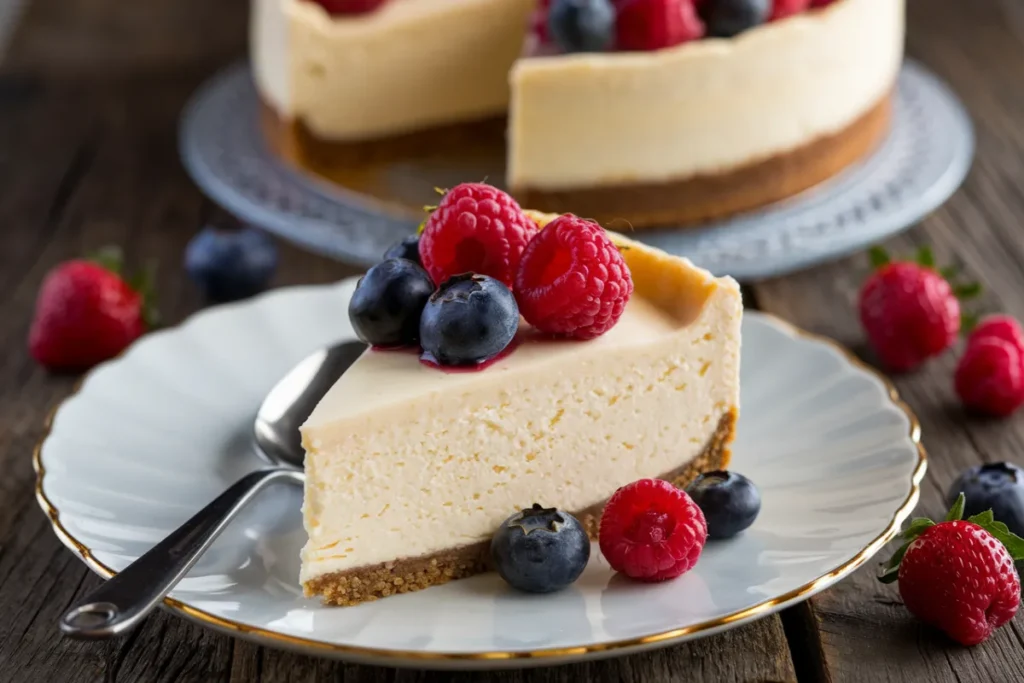Cheesecake is one of those desserts that’s hard to resist. Its creamy texture, the subtle tang of cream cheese, and the buttery crust all come together to create a dessert that’s pure indulgence. But what if you’re gluten intolerant or trying to cut gluten out of your diet? No worries—this gluten-free cheesecake recipe has got you covered.
Ingredients
For the Crust:
- 1 ½ cups gluten-free graham cracker crumbs (or almond flour for a grain-free option)
- ¼ cup granulated sugar
- ½ teaspoon cinnamon (optional, for a little extra warmth)
- 6 tablespoons unsalted butter, melted
For the Filling:
- 3 (8-ounce) packages cream cheese, softened
- 1 cup granulated sugar
- 1 teaspoon vanilla extract
- 3 large eggs
- 1 cup sour cream
- 2 tablespoons cornstarch (to help with setting)
Optional Toppings:
- Fresh berries (strawberries, raspberries, blueberries)
- Chocolate ganache
- Whipped cream
- Caramel sauce
Instructions
1. Preheat and Prep
Preheat your oven to 325°F (165°C). Lightly grease a 9-inch springform pan with butter or non-stick spray. You can also line the bottom with parchment paper for easier removal later.
2. Make the Crust
In a medium-sized mixing bowl, combine the gluten-free graham cracker crumbs, sugar, cinnamon (if using), and melted butter. Mix until the crumbs are evenly coated and resemble wet sand.
Press the mixture firmly into the bottom of the prepared springform pan, ensuring it’s even and compact. Place the pan in the freezer while you prepare the filling, which helps to set the crust.
3. Prepare the Cheesecake Filling
In a large mixing bowl, beat the softened cream cheese with an electric mixer until smooth and creamy, about 2-3 minutes. Gradually add the sugar and continue to beat until well combined and smooth.
Next, add the vanilla extract and mix. Beat in the eggs one at a time, ensuring each is fully incorporated before adding the next. This step is crucial for a smooth texture.
Add the sour cream and cornstarch, mixing on low speed until just combined. Be careful not to overmix, as this can add air bubbles that may cause cracks in your cheesecake.
4. Pour and Smooth
Remove the crust from the freezer and pour the cheesecake filling over it. Use a spatula to smooth the top, ensuring an even surface.
5. Bake in a Water Bath
To prevent cracks and ensure even baking, place the springform pan in a larger baking dish. Carefully pour hot water into the larger dish, about halfway up the side of the springform pan, creating a water bath.
Bake the cheesecake in the preheated oven for 50-60 minutes, or until the edges are set but the center still has a slight jiggle. Turn off the oven and crack the door open, letting the cheesecake cool in the oven for about an hour. This gradual cooling helps prevent cracking.
6. Chill and Set
After an hour, remove the cheesecake from the oven and water bath. Run a knife around the edge to loosen it from the pan and prevent cracks as it cools. Allow it to cool completely on a wire rack before transferring it to the refrigerator. Chill for at least 4 hours, but overnight is best.
7. Serve and Enjoy
Once fully chilled and set, remove the cheesecake from the springform pan. If desired, top with fresh berries, chocolate ganache, whipped cream, or any topping of your choice. Slice and serve—get ready to impress with every creamy bite!
Tips for the Perfect Gluten-Free Cheesecake Recipe

- Room Temperature Ingredients: Make sure all your ingredients (especially the cream cheese, eggs, and sour cream) are at room temperature before you start. This ensures a smooth and creamy filling.
- Don’t Overmix: Overmixing can incorporate too much air, leading to cracks or a denser texture. Mix just until the ingredients are combined.
- Water Bath: This helps prevent cracks and keeps the cheesecake moist. If you’re worried about water leaking into your cheesecake, wrap the springform pan tightly in aluminum foil before placing it in the water bath.
- Slow Cooling: Letting the cheesecake cool slowly in the oven with the door ajar helps prevent drastic temperature changes that could cause cracking.
Frequently Asked Questions (FAQs)
1. Can I make this cheesecake dairy-free as well?
Yes, you can substitute dairy-free cream cheese, sour cream, and butter to make this cheesecake both gluten-free and dairy-free. Just ensure that all your substitutes are certified gluten-free.
2. What can I use instead of graham cracker crumbs for the crust?
You can use almond flour for a grain-free option or gluten-free cookies like ginger snaps for a different flavor.
3. How do I store leftover cheesecake?
Store any leftover cheesecake in an airtight container in the refrigerator for up to 5 days. For longer storage, you can freeze the cheesecake for up to 2 months. Just make sure it’s wrapped tightly to prevent freezer burn.
4. My cheesecake cracked—what did I do wrong?
Cracks can happen for several reasons: overmixing the batter, cooling too quickly, or baking without a water bath. Covering cracks with toppings like berries or ganache is an easy fix!
5. Can I make mini cheesecakes with this recipe?
Absolutely! Simply divide the crust and filling between a muffin tin lined with cupcake liners. Reduce the baking time to 18-22 minutes, or until the centers are set with a slight jiggle.
Wrapping Up for Gluten-Free Cheesecake Recipe
Making a gluten-free cheesecake doesn’t have to be a daunting task. With the right ingredients and a bit of patience, you can create a dessert that’s just as delicious as any traditional cheesecake. Whether you’re gluten-sensitive or simply want to try something new, this recipe is sure to become a favorite in your kitchen. So go ahead—indulge without the gluten and enjoy every creamy, delicious bite!

